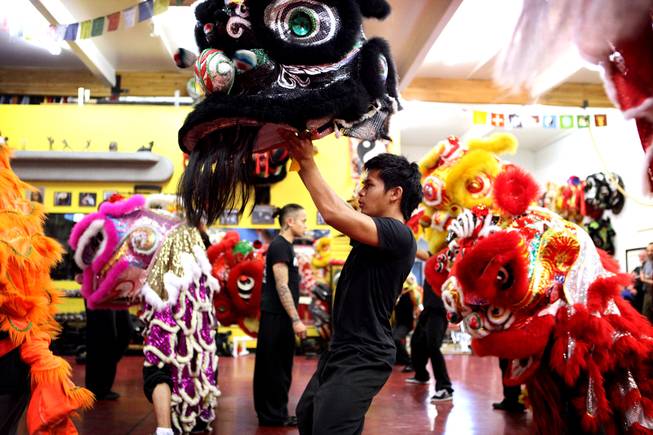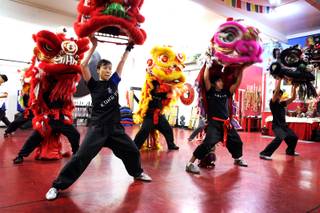
Student Joey DeChavez practices the lion dance for Chinese New Year at Lohan School of Shaolin in Las Vegas on Thursday, January 24, 2013.
Saturday, Feb. 2, 2013 | 2 a.m.
Lion Dance Practice at the Lohan School of Shaolin
Students at the Lohan School of Shaolin practice the lion dance in preparation for the Chinese New Year.
At first glance, a lion dance, the costumed ritual that brings good fortune at Chinese New Year, may seem rather simple.
Yet, from the music to the steps, everything is carefully coordinated. Any absent-minded mistake could mean dooming a client to bad luck for an entire year. The “dancers” are really martial artists, superb athletes with stamina and agility. How else could you grab a head of lettuce hanging 15 feet in the air while donning a costume weighing 25 to 40 pounds?
“We take the lion dance very seriously and want to maintain the traditional style. You cannot be in the lion dance group without being in a martial arts class,” said Steven Baugh, the “Sifu,” or master teacher, at Lohan School of Shaolin in Las Vegas.
The school has the busiest lion dancers in the valley during Chinese New Year, which this year falls on Feb. 10.
It all started with a last-minute phone call and a frantic scramble to come to the aid of a new neighbor.
It was 1995 and Chinatown Plaza had just opened on Spring Mountain Road at Valley View Boulevard.
In Chinese culture, starting the new year with the right traditions sets the tone for the entire year. The new plaza was organizing its first Chinese New Year celebration, and it had to be perfect.
So the management of Chinatown Plaza called Baugh, whom they knew as a local kung fu master. Even though he had never before put a lion dance troupe together, it was something Baugh knew from his own training. School members performed the lion dance that year for the plaza’s Chinese New Year festival, and now, at the start of every year the school’s lion dancers do their best to bring good luck to Strip casinos and small businesses alike.
“We use them every year now,” said Tina Lee, event coordinator for the Chinatown Plaza New Year’s festival, which this year is Feb. 17. “When we opened we didn’t know anybody, and they came out to perform for us, and since then we have really built a relationship. They are a great group that is creative but also respects the traditional way of the lion dance.”
These days, calls start coming in May to book the lion dancers for the following year’s Chinese New Year. In all, the dancers will perform more than 70 times, including multiple dances at places such as Caesars Palace, the Rio, Planet Hollywood, Fremont Street Experience, Paris, and numerous shops, restaurants and markets throughout the valley.
In 2001, Baugh and his students were called upon to perform a lion dance for the film “Rush Hour 2,” starring Jackie Chan and Chris Tucker.
“More than the other classes, the lion dance really creates a family atmosphere at the school,” Baugh said. “You have to rely on someone else, and it builds teamwork. When the beat changes, the dancers must be in unison. You don’t know exactly what kind of space you will be in when you’re hired, so you have to adapt to the environment.”
The lion dance traces its origins back thousands of years to ancient China. As the tradition spread, different versions developed in various regions. For true believers, it is important that the dance be done properly to avoid bad luck for an entire year.
The lion dance often is confused with the dragon dance, which comes from the same tradition but is less common. One of the main differences is that a lion dance is a two-person performance, while a dragon dance can involve dozens of performers.
“The dragon dance was traditionally for royalty and very special occasions,” said Baugh, who also has a dragon dance troupe at the school.
The lion rids a business of bad spirits, and the dance must follow a certain process. Accompanied by drums and cymbals, the lion approaches the doorway with specific steps and sniffs around looking for ghosts. The lion circles, steps back, approaches the door and sniffs again. When the lion finally enters, it is considered bad luck for it to step on the threshold.
The client will have decorative envelopes with payment and also leave out a head of lettuce. For a better show, those who hire lion dancers will place the lettuce up high, demanding an acrobatic display from the performers to capture it.
The dancers grab the lettuce, symbolizing money and prosperity, tear it up from within the costume and then “spit” it back out over the store.
“Sometimes the owner of the store stands right there in the middle when the lion tears up the lettuce and spits it out,” Baugh said. “They think it's good luck to get pelted with lettuce scraps.”
Other items, such as oranges, can be left out for the lion to snatch. The performer grabs the orange, whips out a concealed box cutter and quickly makes the orange peel into a flower before presenting it to the client. In general, the more difficult the task for the lion, the bigger the payment should be.
The lion dance movements are rooted in martial arts, and the performers make swift, crisp movements, all set to music, while manipulating heavy costumes.
“They are the best around,” Lee said of Baugh’s lion dancers. “Every year when they perform, they come up with something new. They will even mix some hip-hop into the dance. And they are the only school that does the dragon parade.”
Part of the dancers’ objective is to animate the costume, to truly mimic motions that call to mind a lion’s movements, how it sniffs the air and paws the ground.
The lion costumes are intricate, expensive and meant for an objective. Every lion has a horn on its head for charging into the building and forcing out bad spirits. There also is a mirror to cast away demons. At practice, performers move with such purpose and force that pieces of the mask and tail fall to the floor with regularity.
The costumes can cost $800 to $1,200, and Baugh’s wife, Syd, a champion martial artist herself, does the tedious repair work each year to keep costs down. The big casinos like the costumes to reflect Las Vegas: loud, bright and covered in sparkles, and Syd Baugh obliges.
Steven Baugh still has a soft spot for the more traditional style, almost embarrassed by the bedazzled pink lion costume the casinos favor.
Baugh bases his lion dance on the tradition of the three brothers of the peach orchard who vowed to restore the Han dynasty and are chronicled in “Romance of the Three Kingdoms.” The lions, yellow, red and black, each represent one of the brothers and their personality. The yellow lion is wise, the red lion is strong and the black lion has a quick temper. Other colors are used, Baugh said, for different occasions, such as white for a funeral procession.
“If a business is having trouble with employees stealing, for example, they will call and ask for the black lion,” Baugh said. “For specific situations, you need the right lion.”
The school is set up as a nonprofit entity, and Baugh said much of the budget comes from money earned during two weeks surrounding Chinese New Year. Baugh visibly enjoys watching the students he teaches pass down the kung fu, tai chi, lion dance and other disciplines he imparts to them. The youngest lion dancer is his 5-year-old grandson.
“We are working on a new lion dance routine for the schools,” Baugh said. “The kids really love it, and it gets them interested in the traditions. The students we have here, this is what they do. They don’t play sports. Those things are games; (martial arts) offers a way of life.”


Join the Discussion:
Check this out for a full explanation of our conversion to the LiveFyre commenting system and instructions on how to sign up for an account.
Full comments policy